A well-designed and well-assembled electrical panel in a private house is a guarantee of the safety of the entire power supply system. Since metering devices, as well as distribution and protective equipment are located inside the cabinet structure, increased attention is paid to its selection and independent production. According to the main provisions of the PUE, the introductory panel must meet the most stringent requirements regarding operational safety and the possibility of expanding its functionality.
What is the shield for?
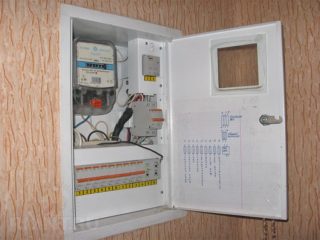
Previously, in private houses, separate introductory cabinets that took up space in the premises and did not fit into the interiors, as a rule, were not made. They were traditionally installed outside the building in separate booths on a high-voltage pole. Today the situation has changed dramatically, so it is not possible to do with junction boxes alone. The need to assemble a 220 Volt electrical panel for a private house is due to the following reasons:
- an increasing number of users prefer to independently monitor the status of equipment that controls power consumption, as well as overvoltage and short circuit protection;
- the number of devices used for these purposes is steadily growing every year and requires more space for its placement;
- cupboard products appeared that do not spoil modern interiors with their design: they have an attractive appearance and are easy to use, and are distinguished by increased safety.
In the conditions of a wooden house, the importance of a switch cabinet increases significantly, since in a private household the possibilities for increasing electrical equipment are great. They are limited only by the limit of electricity calculated in kWh.
Types of shields for a private house
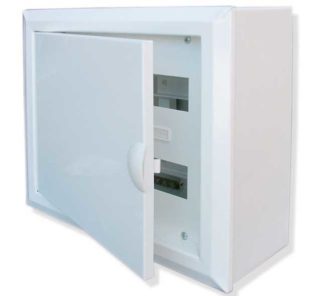
Electrical panels are designed for the safe supply and distribution of electricity throughout a private house. Depending on their functional purpose, they are divided into the following types:
- Input devices, equipped at the place where the power cable is supplied.
- Boxes for installing a portable electric meter.
- Distribution boards mounted directly in the house and designed for the distribution of internal supply lines, as well as their protection.
They practically do not differ from the same products installed in apartments in city buildings. The difference usually manifests itself only in the fact that significantly more samples of control, protective and distribution equipment are installed in them. In private households, it is also possible to make a separate panel designed specifically for servicing lighting lines.
Choosing a location
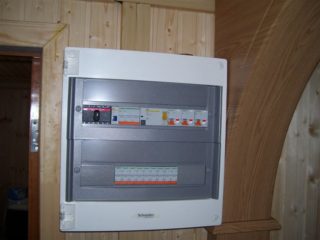
Before you make an electrical panel for a summer residence or at home with your own hands, you should worry about choosing a place for it. It is most convenient to hang the cabinet on a section of the wall near the front door in the hallway area. In this case, the distance from the post with the branch will be minimal, the length of the cable to be laid is short. It is placed in height so that it is convenient to take meter readings and switch distribution (linear) machines.
Unlike old shields with open plugs and switches, new products do not have to be placed high above the ceiling.
The body of the product reliably covers elements of switching equipment dangerous for children. The main thing is to provide a reliable lock that can only be opened with a key.
When determining the location for installing the shield, it is also important to consider how and where exactly the power cable is started. When electrifying a new building, data on the layouts of external networks can be obtained from the specialists of the local branch of Energosbyt.
Buy a ready-made electrical panel for installation in an apartment or assemble it yourself
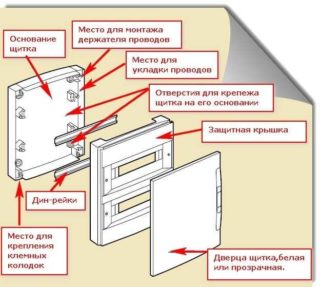
Typical cabinets and shields for single-phase or three-phase networks are available in a wide variety of configurations, often their design is developed to order. You can buy a ready-made cabinet already fully equipped with everything you need and then add the necessary equipment to the DIN rail. It is even easier to purchase only the case of the future shield with all the installation accessories, and then assemble it yourself almost from scratch.
The positive aspects of this approach are:
- significant cost savings;
- the ability to mount installation elements and devices at your own discretion, without going beyond the fundamental limitations;
- a clear understanding of how the circuit of an electrical panel assembled on our own is arranged.
A competent approach to choosing the right solution takes into account such factors as the ease of maintenance of the equipment and its maintainability. It will be much easier to carry out these operations with a self-equipped cabinet.
Shield elements and assembly order

A competently assembled shield circuit is the basis for the normal operation of the entire power supply system of a house. Therefore, it is important to immediately understand the composition of the future switchgear. You will need to place the following elements:
- DIN rails used for fixing electrical devices.
- Grounding bars, made in the form of strips with a set of mounting holes.
- Introductory machine.
- An electric meter mounted next to it.
- Residual current devices (RCDs).
- Linear circuit breakers.
- Overvoltage protection relays and other devices.
As a rule, there are no special difficulties with the installation and connection of most of the listed devices. The only thing that you should pay attention to is the validity of using an RCD and a voltage relay. The electrical panel circuit in the apartment with an RCD and a voltage relay guarantees its user protection against electric shock and potential drops. Therefore, their installation in a private residential building is considered mandatory.
When assembling the flap with their own hands, they are guided by the documentation attached to any samples of this type of product. It provides step-by-step instructions on how to install all components and how to fix them.
Calculation of the number of modules
The enclosures are sold with DIN rails already fixed in them, designed for a given number of devices, which is indicated in the product name. This characteristic is understood as the number of elements in a multiplicity of one module (18 mm), freely placed on the fixing rail. To determine their exact number, you will need to add the dimensions of all installed products in the modules, taking into account the margin for the gaps between them (3-4 mm).
In the description of some cabinets, fixing rails with end caps are mentioned, after removing which it is possible to free up another seat. When self-assembling, it is better to plan the number of such modules with a small margin. If the approximate calculations gave the number 66, it is advisable to choose a box for 72 module-places.
Case selection
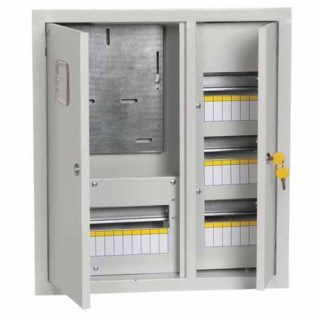
Housings of shields differ in the material used for their manufacture (metal or plastic), as well as the degree of tightness.Metal cabinets are highly durable and can withstand significant loads. They are suitable in a situation where a three-phase power supply is introduced into the house, requiring the installation of a large number of protective devices.
Since in a private household such a cabinet is usually installed within the house, it is not so important to take care of its tightness. An exception is the case when it comes to a box for a portable electric meter, placed on the front wall of the house. According to the method of installation within the boundaries of the structure, the cabinets can be hinged or built into a special niche in the wall.
In the first case, they will protrude outward, occupying some part of the living space, and in the second, they will be completely recessed in the thickness of the walls. The choice is at the discretion of the landlord. Plastic cabinets are available in both versions and are usually chosen to accommodate small-volume assemblies serving country houses or small cottages. In terms of strength and IP climatic protection, they are not inferior to their metal counterparts.
Useful Tips

When choosing, installing and then disconnecting the shield in a private house, it is recommended to take into account the following nuances:
- the size and number of mounted DIN rails should be taken with a margin, this will come in handy if you need to place new equipment;
- with a three-phase power supply of the power outlet line and lighting control, it is advisable to power it from a separate panel;
- in order to increase the reliability of such systems in the cabinet, it will be necessary to provide for a breakdown of devices into groups and levels of protection.
Subject to all the rules and recommendations, anyone will be able to independently assemble and disconnect the cabinet that serves the electrical network of a private house.








